Exploring the Significance of Community in Early Childhood Services
VerifiedAdded on 2023/06/04
|9
|2372
|394
Report
AI Summary
This report examines the significance of a sense of community in early childhood services, emphasizing its impact on children's cognitive, effective, and psychomotor skills. It highlights the role of communities and families in children's learning and development, discussing how educators can foster a sense of community both within and outside the learning center. The report also covers the importance of community practices and culture, the role of service providers, and the ways in which children learn through observation and participation. Ultimately, it concludes that a strong sense of community is crucial for shaping children's future behavior, learning abilities, and perceptions of the environment, advocating for collaborative efforts among educators, families, and communities to nurture this sense in children.
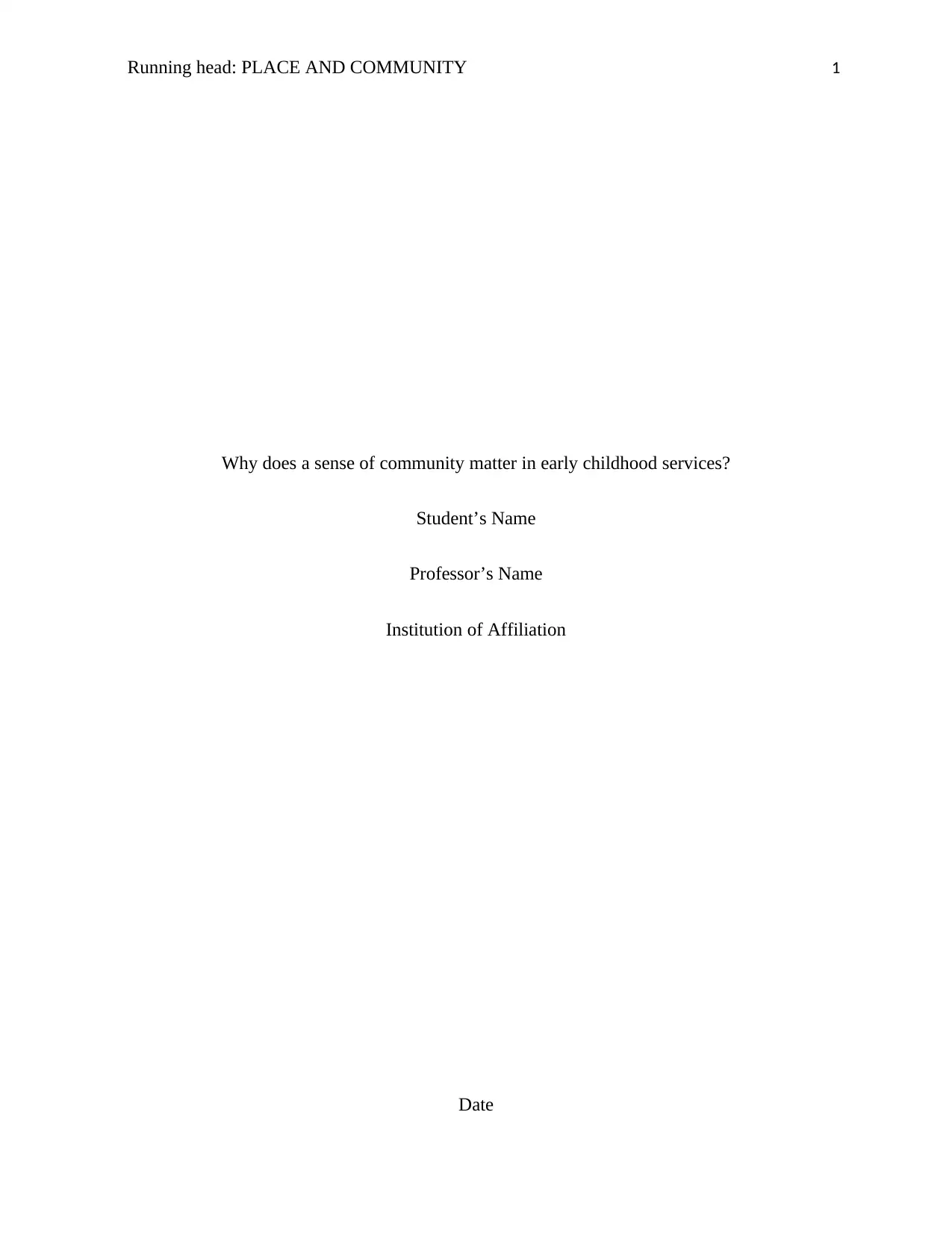
Running head: PLACE AND COMMUNITY 1
Why does a sense of community matter in early childhood services?
Student’s Name
Professor’s Name
Institution of Affiliation
Date
Why does a sense of community matter in early childhood services?
Student’s Name
Professor’s Name
Institution of Affiliation
Date
Secure Best Marks with AI Grader
Need help grading? Try our AI Grader for instant feedback on your assignments.
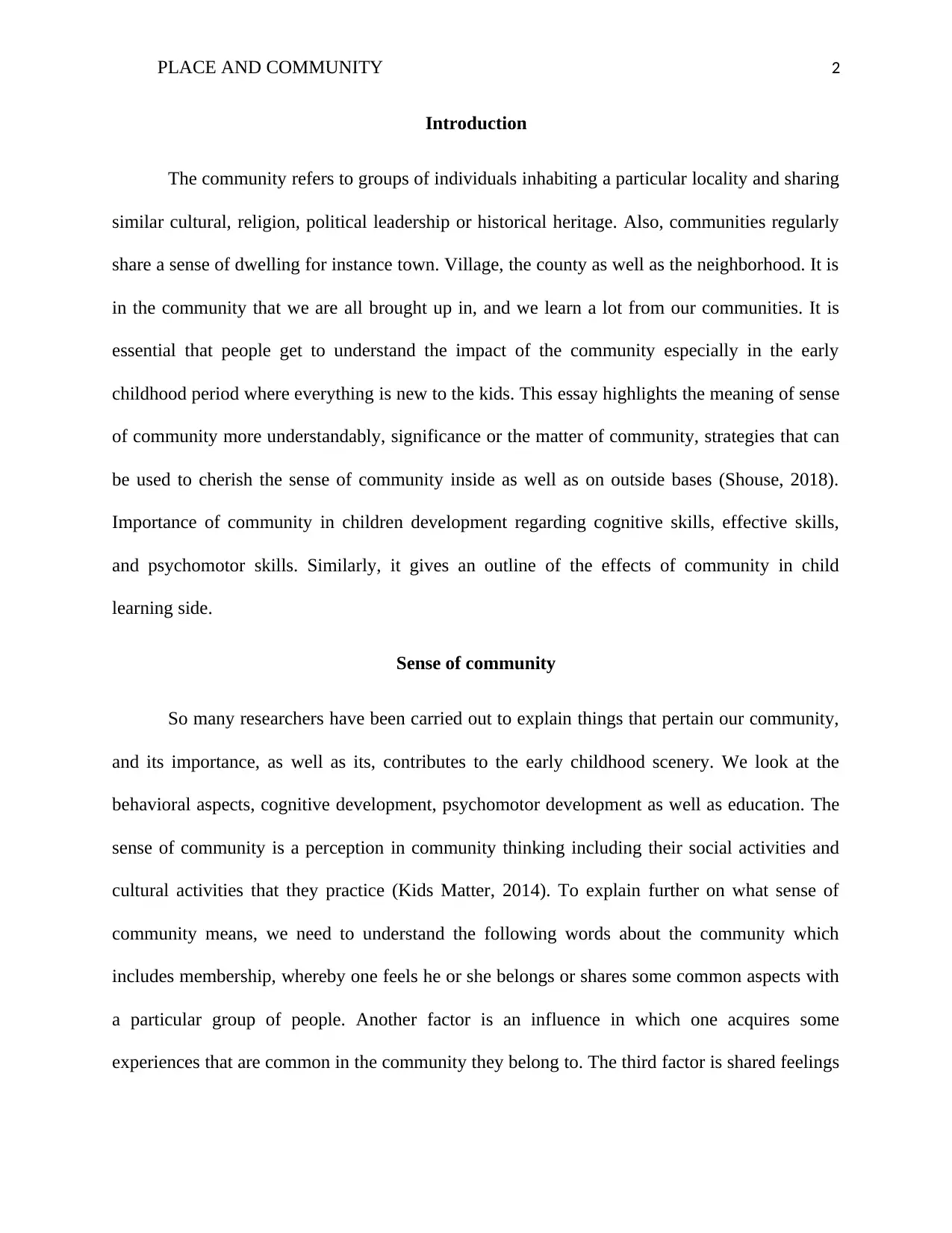
PLACE AND COMMUNITY 2
Introduction
The community refers to groups of individuals inhabiting a particular locality and sharing
similar cultural, religion, political leadership or historical heritage. Also, communities regularly
share a sense of dwelling for instance town. Village, the county as well as the neighborhood. It is
in the community that we are all brought up in, and we learn a lot from our communities. It is
essential that people get to understand the impact of the community especially in the early
childhood period where everything is new to the kids. This essay highlights the meaning of sense
of community more understandably, significance or the matter of community, strategies that can
be used to cherish the sense of community inside as well as on outside bases (Shouse, 2018).
Importance of community in children development regarding cognitive skills, effective skills,
and psychomotor skills. Similarly, it gives an outline of the effects of community in child
learning side.
Sense of community
So many researchers have been carried out to explain things that pertain our community,
and its importance, as well as its, contributes to the early childhood scenery. We look at the
behavioral aspects, cognitive development, psychomotor development as well as education. The
sense of community is a perception in community thinking including their social activities and
cultural activities that they practice (Kids Matter, 2014). To explain further on what sense of
community means, we need to understand the following words about the community which
includes membership, whereby one feels he or she belongs or shares some common aspects with
a particular group of people. Another factor is an influence in which one acquires some
experiences that are common in the community they belong to. The third factor is shared feelings
Introduction
The community refers to groups of individuals inhabiting a particular locality and sharing
similar cultural, religion, political leadership or historical heritage. Also, communities regularly
share a sense of dwelling for instance town. Village, the county as well as the neighborhood. It is
in the community that we are all brought up in, and we learn a lot from our communities. It is
essential that people get to understand the impact of the community especially in the early
childhood period where everything is new to the kids. This essay highlights the meaning of sense
of community more understandably, significance or the matter of community, strategies that can
be used to cherish the sense of community inside as well as on outside bases (Shouse, 2018).
Importance of community in children development regarding cognitive skills, effective skills,
and psychomotor skills. Similarly, it gives an outline of the effects of community in child
learning side.
Sense of community
So many researchers have been carried out to explain things that pertain our community,
and its importance, as well as its, contributes to the early childhood scenery. We look at the
behavioral aspects, cognitive development, psychomotor development as well as education. The
sense of community is a perception in community thinking including their social activities and
cultural activities that they practice (Kids Matter, 2014). To explain further on what sense of
community means, we need to understand the following words about the community which
includes membership, whereby one feels he or she belongs or shares some common aspects with
a particular group of people. Another factor is an influence in which one acquires some
experiences that are common in the community they belong to. The third factor is shared feelings
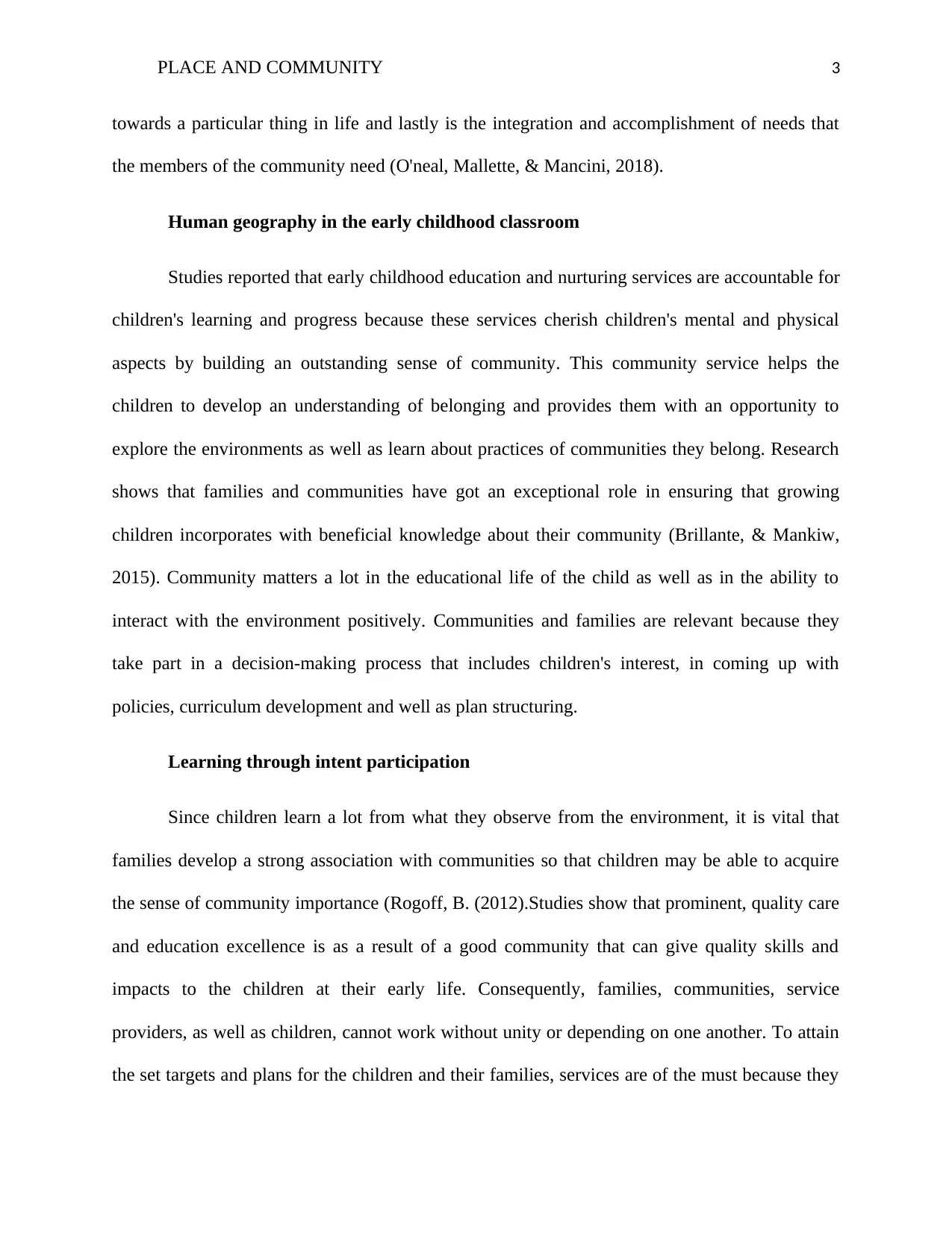
PLACE AND COMMUNITY 3
towards a particular thing in life and lastly is the integration and accomplishment of needs that
the members of the community need (O'neal, Mallette, & Mancini, 2018).
Human geography in the early childhood classroom
Studies reported that early childhood education and nurturing services are accountable for
children's learning and progress because these services cherish children's mental and physical
aspects by building an outstanding sense of community. This community service helps the
children to develop an understanding of belonging and provides them with an opportunity to
explore the environments as well as learn about practices of communities they belong. Research
shows that families and communities have got an exceptional role in ensuring that growing
children incorporates with beneficial knowledge about their community (Brillante, & Mankiw,
2015). Community matters a lot in the educational life of the child as well as in the ability to
interact with the environment positively. Communities and families are relevant because they
take part in a decision-making process that includes children's interest, in coming up with
policies, curriculum development and well as plan structuring.
Learning through intent participation
Since children learn a lot from what they observe from the environment, it is vital that
families develop a strong association with communities so that children may be able to acquire
the sense of community importance (Rogoff, B. (2012).Studies show that prominent, quality care
and education excellence is as a result of a good community that can give quality skills and
impacts to the children at their early life. Consequently, families, communities, service
providers, as well as children, cannot work without unity or depending on one another. To attain
the set targets and plans for the children and their families, services are of the must because they
towards a particular thing in life and lastly is the integration and accomplishment of needs that
the members of the community need (O'neal, Mallette, & Mancini, 2018).
Human geography in the early childhood classroom
Studies reported that early childhood education and nurturing services are accountable for
children's learning and progress because these services cherish children's mental and physical
aspects by building an outstanding sense of community. This community service helps the
children to develop an understanding of belonging and provides them with an opportunity to
explore the environments as well as learn about practices of communities they belong. Research
shows that families and communities have got an exceptional role in ensuring that growing
children incorporates with beneficial knowledge about their community (Brillante, & Mankiw,
2015). Community matters a lot in the educational life of the child as well as in the ability to
interact with the environment positively. Communities and families are relevant because they
take part in a decision-making process that includes children's interest, in coming up with
policies, curriculum development and well as plan structuring.
Learning through intent participation
Since children learn a lot from what they observe from the environment, it is vital that
families develop a strong association with communities so that children may be able to acquire
the sense of community importance (Rogoff, B. (2012).Studies show that prominent, quality care
and education excellence is as a result of a good community that can give quality skills and
impacts to the children at their early life. Consequently, families, communities, service
providers, as well as children, cannot work without unity or depending on one another. To attain
the set targets and plans for the children and their families, services are of the must because they
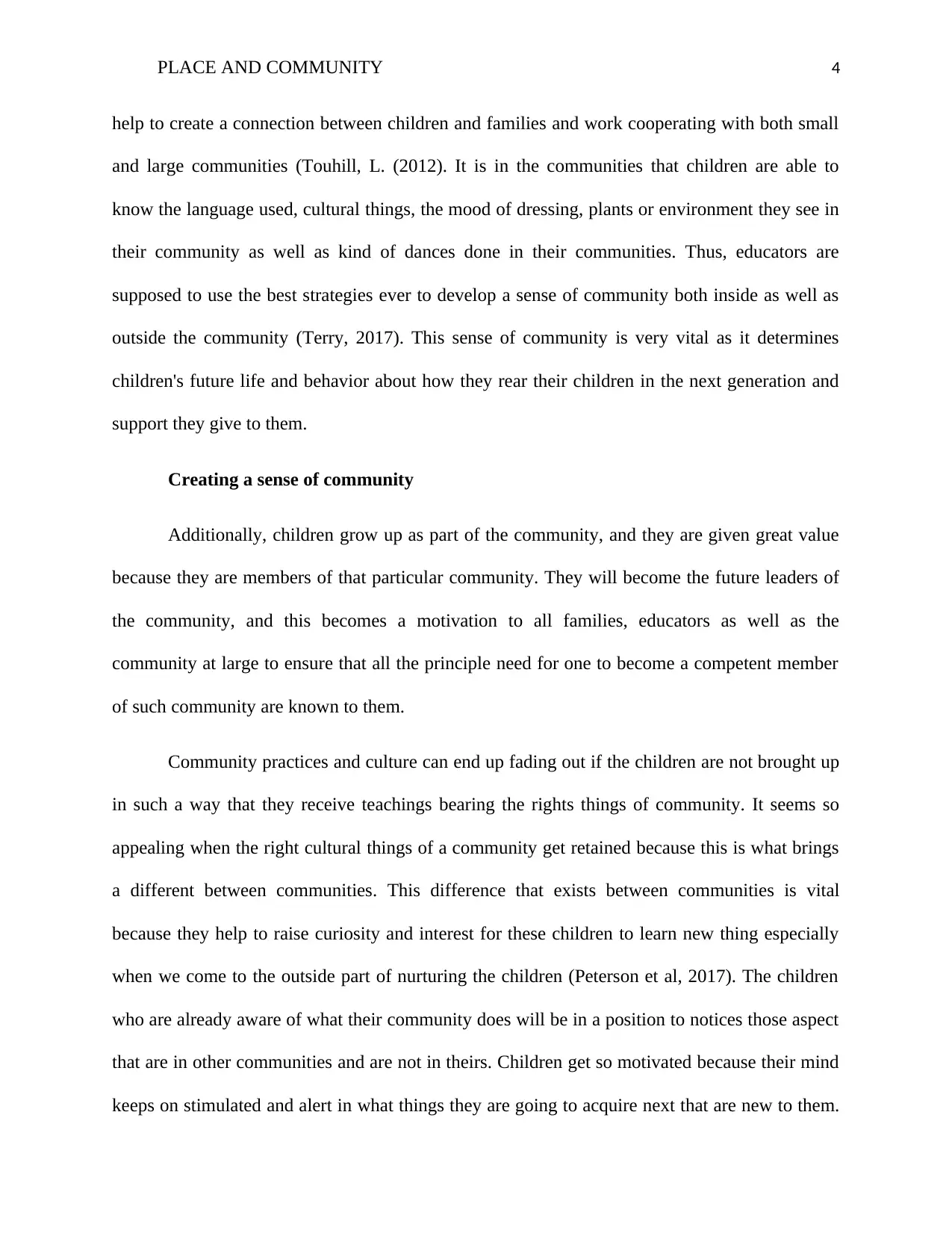
PLACE AND COMMUNITY 4
help to create a connection between children and families and work cooperating with both small
and large communities (Touhill, L. (2012). It is in the communities that children are able to
know the language used, cultural things, the mood of dressing, plants or environment they see in
their community as well as kind of dances done in their communities. Thus, educators are
supposed to use the best strategies ever to develop a sense of community both inside as well as
outside the community (Terry, 2017). This sense of community is very vital as it determines
children's future life and behavior about how they rear their children in the next generation and
support they give to them.
Creating a sense of community
Additionally, children grow up as part of the community, and they are given great value
because they are members of that particular community. They will become the future leaders of
the community, and this becomes a motivation to all families, educators as well as the
community at large to ensure that all the principle need for one to become a competent member
of such community are known to them.
Community practices and culture can end up fading out if the children are not brought up
in such a way that they receive teachings bearing the rights things of community. It seems so
appealing when the right cultural things of a community get retained because this is what brings
a different between communities. This difference that exists between communities is vital
because they help to raise curiosity and interest for these children to learn new thing especially
when we come to the outside part of nurturing the children (Peterson et al, 2017). The children
who are already aware of what their community does will be in a position to notices those aspect
that are in other communities and are not in theirs. Children get so motivated because their mind
keeps on stimulated and alert in what things they are going to acquire next that are new to them.
help to create a connection between children and families and work cooperating with both small
and large communities (Touhill, L. (2012). It is in the communities that children are able to
know the language used, cultural things, the mood of dressing, plants or environment they see in
their community as well as kind of dances done in their communities. Thus, educators are
supposed to use the best strategies ever to develop a sense of community both inside as well as
outside the community (Terry, 2017). This sense of community is very vital as it determines
children's future life and behavior about how they rear their children in the next generation and
support they give to them.
Creating a sense of community
Additionally, children grow up as part of the community, and they are given great value
because they are members of that particular community. They will become the future leaders of
the community, and this becomes a motivation to all families, educators as well as the
community at large to ensure that all the principle need for one to become a competent member
of such community are known to them.
Community practices and culture can end up fading out if the children are not brought up
in such a way that they receive teachings bearing the rights things of community. It seems so
appealing when the right cultural things of a community get retained because this is what brings
a different between communities. This difference that exists between communities is vital
because they help to raise curiosity and interest for these children to learn new thing especially
when we come to the outside part of nurturing the children (Peterson et al, 2017). The children
who are already aware of what their community does will be in a position to notices those aspect
that are in other communities and are not in theirs. Children get so motivated because their mind
keeps on stimulated and alert in what things they are going to acquire next that are new to them.
Secure Best Marks with AI Grader
Need help grading? Try our AI Grader for instant feedback on your assignments.
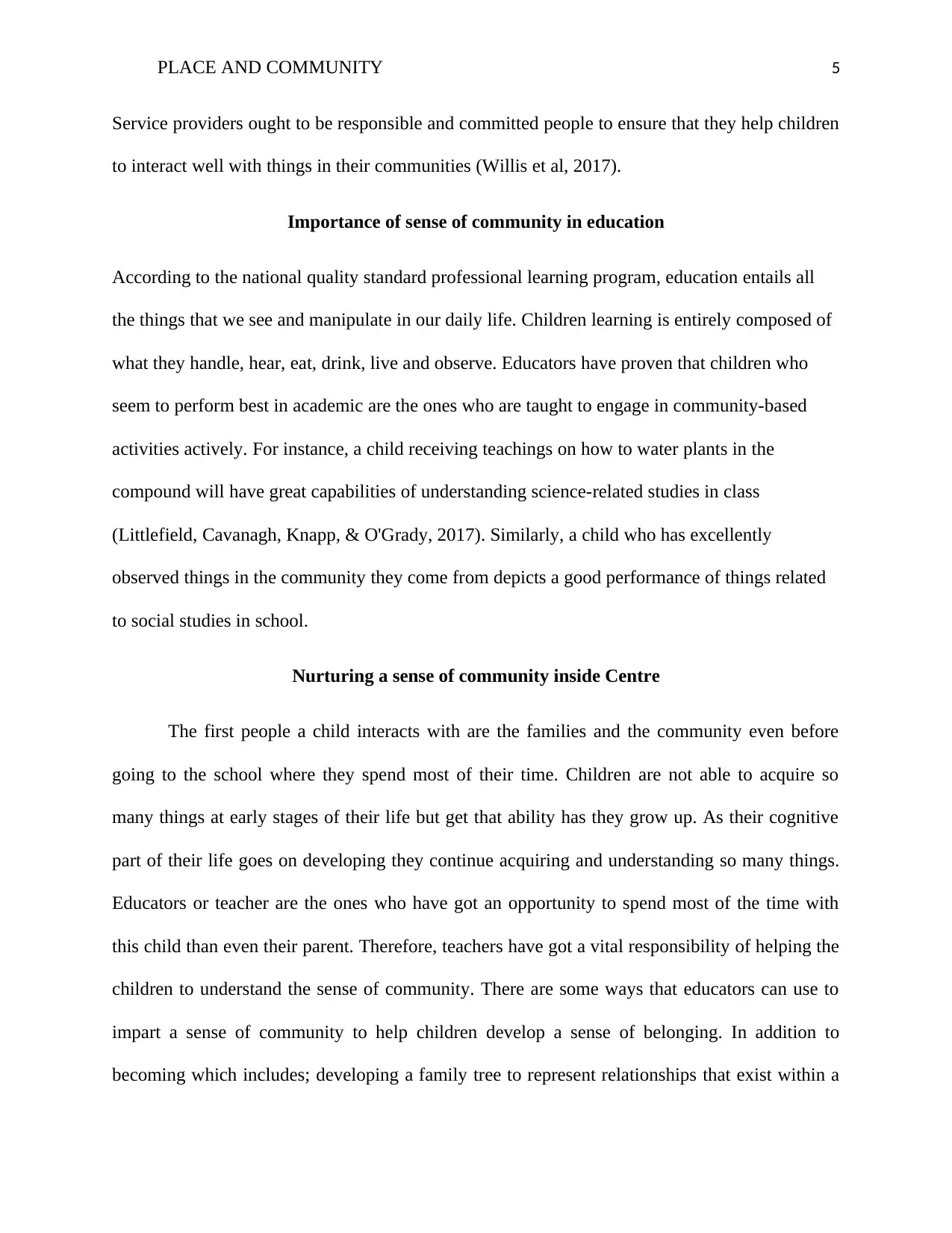
PLACE AND COMMUNITY 5
Service providers ought to be responsible and committed people to ensure that they help children
to interact well with things in their communities (Willis et al, 2017).
Importance of sense of community in education
According to the national quality standard professional learning program, education entails all
the things that we see and manipulate in our daily life. Children learning is entirely composed of
what they handle, hear, eat, drink, live and observe. Educators have proven that children who
seem to perform best in academic are the ones who are taught to engage in community-based
activities actively. For instance, a child receiving teachings on how to water plants in the
compound will have great capabilities of understanding science-related studies in class
(Littlefield, Cavanagh, Knapp, & O'Grady, 2017). Similarly, a child who has excellently
observed things in the community they come from depicts a good performance of things related
to social studies in school.
Nurturing a sense of community inside Centre
The first people a child interacts with are the families and the community even before
going to the school where they spend most of their time. Children are not able to acquire so
many things at early stages of their life but get that ability has they grow up. As their cognitive
part of their life goes on developing they continue acquiring and understanding so many things.
Educators or teacher are the ones who have got an opportunity to spend most of the time with
this child than even their parent. Therefore, teachers have got a vital responsibility of helping the
children to understand the sense of community. There are some ways that educators can use to
impart a sense of community to help children develop a sense of belonging. In addition to
becoming which includes; developing a family tree to represent relationships that exist within a
Service providers ought to be responsible and committed people to ensure that they help children
to interact well with things in their communities (Willis et al, 2017).
Importance of sense of community in education
According to the national quality standard professional learning program, education entails all
the things that we see and manipulate in our daily life. Children learning is entirely composed of
what they handle, hear, eat, drink, live and observe. Educators have proven that children who
seem to perform best in academic are the ones who are taught to engage in community-based
activities actively. For instance, a child receiving teachings on how to water plants in the
compound will have great capabilities of understanding science-related studies in class
(Littlefield, Cavanagh, Knapp, & O'Grady, 2017). Similarly, a child who has excellently
observed things in the community they come from depicts a good performance of things related
to social studies in school.
Nurturing a sense of community inside Centre
The first people a child interacts with are the families and the community even before
going to the school where they spend most of their time. Children are not able to acquire so
many things at early stages of their life but get that ability has they grow up. As their cognitive
part of their life goes on developing they continue acquiring and understanding so many things.
Educators or teacher are the ones who have got an opportunity to spend most of the time with
this child than even their parent. Therefore, teachers have got a vital responsibility of helping the
children to understand the sense of community. There are some ways that educators can use to
impart a sense of community to help children develop a sense of belonging. In addition to
becoming which includes; developing a family tree to represent relationships that exist within a
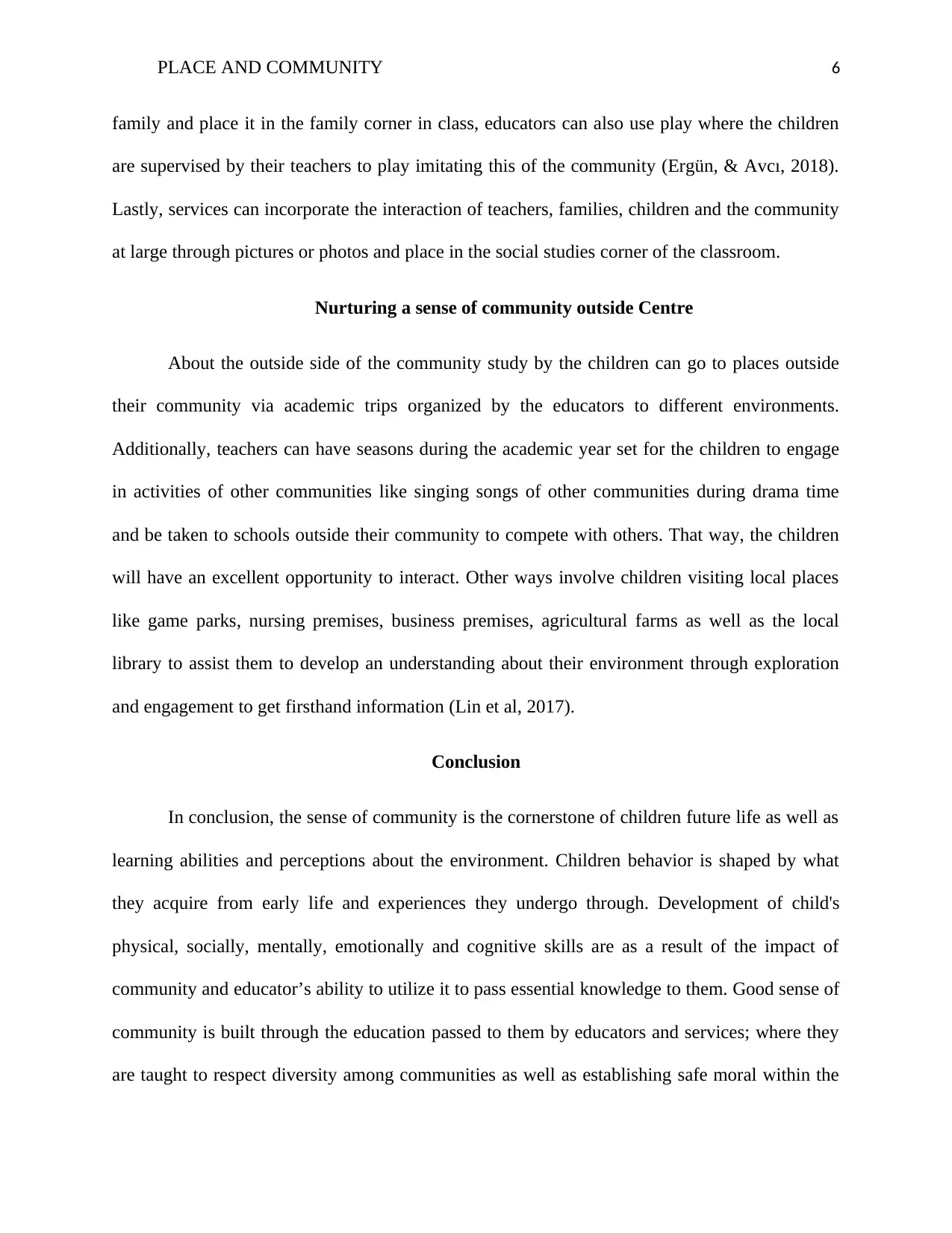
PLACE AND COMMUNITY 6
family and place it in the family corner in class, educators can also use play where the children
are supervised by their teachers to play imitating this of the community (Ergün, & Avcı, 2018).
Lastly, services can incorporate the interaction of teachers, families, children and the community
at large through pictures or photos and place in the social studies corner of the classroom.
Nurturing a sense of community outside Centre
About the outside side of the community study by the children can go to places outside
their community via academic trips organized by the educators to different environments.
Additionally, teachers can have seasons during the academic year set for the children to engage
in activities of other communities like singing songs of other communities during drama time
and be taken to schools outside their community to compete with others. That way, the children
will have an excellent opportunity to interact. Other ways involve children visiting local places
like game parks, nursing premises, business premises, agricultural farms as well as the local
library to assist them to develop an understanding about their environment through exploration
and engagement to get firsthand information (Lin et al, 2017).
Conclusion
In conclusion, the sense of community is the cornerstone of children future life as well as
learning abilities and perceptions about the environment. Children behavior is shaped by what
they acquire from early life and experiences they undergo through. Development of child's
physical, socially, mentally, emotionally and cognitive skills are as a result of the impact of
community and educator’s ability to utilize it to pass essential knowledge to them. Good sense of
community is built through the education passed to them by educators and services; where they
are taught to respect diversity among communities as well as establishing safe moral within the
family and place it in the family corner in class, educators can also use play where the children
are supervised by their teachers to play imitating this of the community (Ergün, & Avcı, 2018).
Lastly, services can incorporate the interaction of teachers, families, children and the community
at large through pictures or photos and place in the social studies corner of the classroom.
Nurturing a sense of community outside Centre
About the outside side of the community study by the children can go to places outside
their community via academic trips organized by the educators to different environments.
Additionally, teachers can have seasons during the academic year set for the children to engage
in activities of other communities like singing songs of other communities during drama time
and be taken to schools outside their community to compete with others. That way, the children
will have an excellent opportunity to interact. Other ways involve children visiting local places
like game parks, nursing premises, business premises, agricultural farms as well as the local
library to assist them to develop an understanding about their environment through exploration
and engagement to get firsthand information (Lin et al, 2017).
Conclusion
In conclusion, the sense of community is the cornerstone of children future life as well as
learning abilities and perceptions about the environment. Children behavior is shaped by what
they acquire from early life and experiences they undergo through. Development of child's
physical, socially, mentally, emotionally and cognitive skills are as a result of the impact of
community and educator’s ability to utilize it to pass essential knowledge to them. Good sense of
community is built through the education passed to them by educators and services; where they
are taught to respect diversity among communities as well as establishing safe moral within the
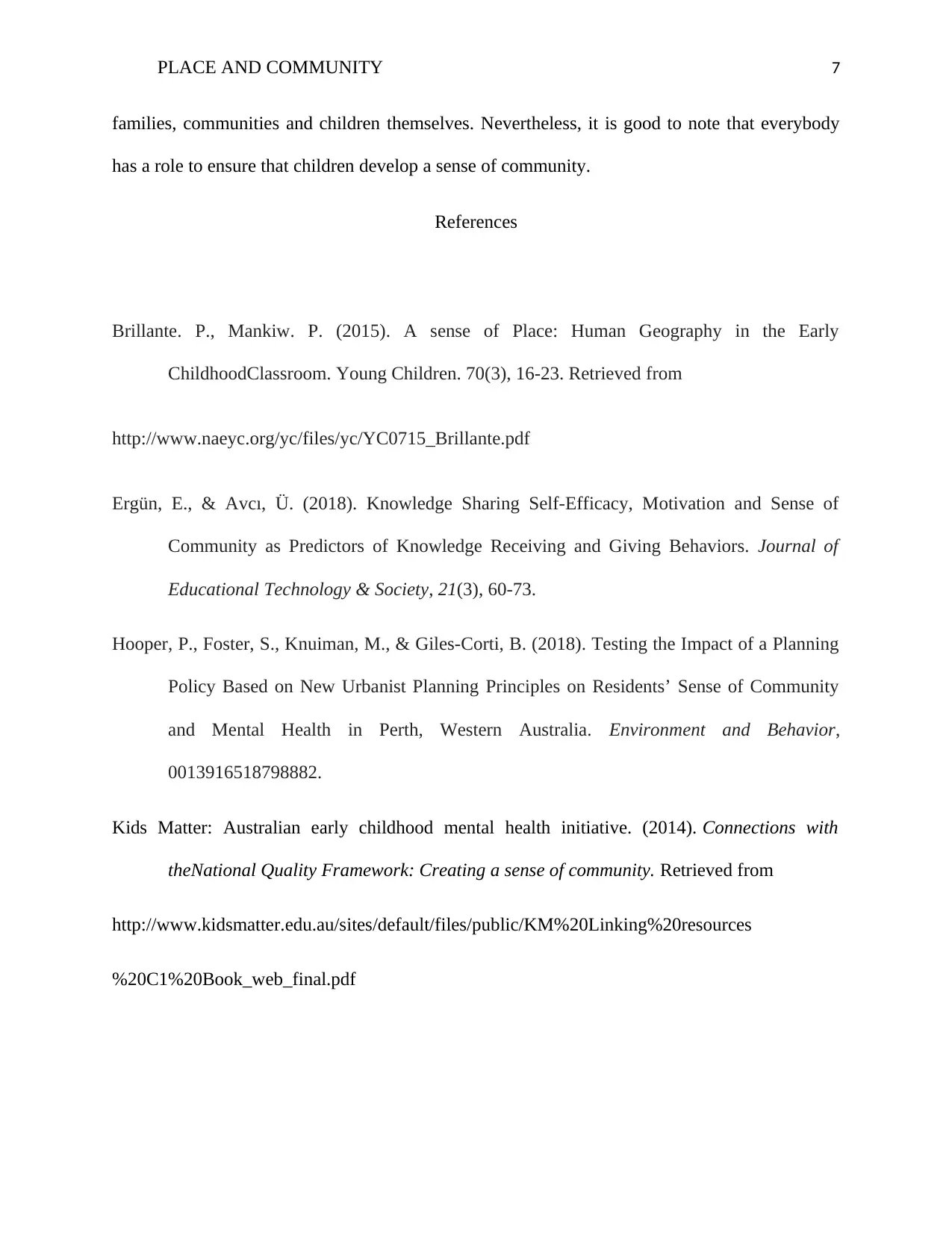
PLACE AND COMMUNITY 7
families, communities and children themselves. Nevertheless, it is good to note that everybody
has a role to ensure that children develop a sense of community.
References
Brillante. P., Mankiw. P. (2015). A sense of Place: Human Geography in the Early
ChildhoodClassroom. Young Children. 70(3), 16-23. Retrieved from
http://www.naeyc.org/yc/files/yc/YC0715_Brillante.pdf
Ergün, E., & Avcı, Ü. (2018). Knowledge Sharing Self-Efficacy, Motivation and Sense of
Community as Predictors of Knowledge Receiving and Giving Behaviors. Journal of
Educational Technology & Society, 21(3), 60-73.
Hooper, P., Foster, S., Knuiman, M., & Giles-Corti, B. (2018). Testing the Impact of a Planning
Policy Based on New Urbanist Planning Principles on Residents’ Sense of Community
and Mental Health in Perth, Western Australia. Environment and Behavior,
0013916518798882.
Kids Matter: Australian early childhood mental health initiative. (2014). Connections with
theNational Quality Framework: Creating a sense of community. Retrieved from
http://www.kidsmatter.edu.au/sites/default/files/public/KM%20Linking%20resources
%20C1%20Book_web_final.pdf
families, communities and children themselves. Nevertheless, it is good to note that everybody
has a role to ensure that children develop a sense of community.
References
Brillante. P., Mankiw. P. (2015). A sense of Place: Human Geography in the Early
ChildhoodClassroom. Young Children. 70(3), 16-23. Retrieved from
http://www.naeyc.org/yc/files/yc/YC0715_Brillante.pdf
Ergün, E., & Avcı, Ü. (2018). Knowledge Sharing Self-Efficacy, Motivation and Sense of
Community as Predictors of Knowledge Receiving and Giving Behaviors. Journal of
Educational Technology & Society, 21(3), 60-73.
Hooper, P., Foster, S., Knuiman, M., & Giles-Corti, B. (2018). Testing the Impact of a Planning
Policy Based on New Urbanist Planning Principles on Residents’ Sense of Community
and Mental Health in Perth, Western Australia. Environment and Behavior,
0013916518798882.
Kids Matter: Australian early childhood mental health initiative. (2014). Connections with
theNational Quality Framework: Creating a sense of community. Retrieved from
http://www.kidsmatter.edu.au/sites/default/files/public/KM%20Linking%20resources
%20C1%20Book_web_final.pdf
Paraphrase This Document
Need a fresh take? Get an instant paraphrase of this document with our AI Paraphraser
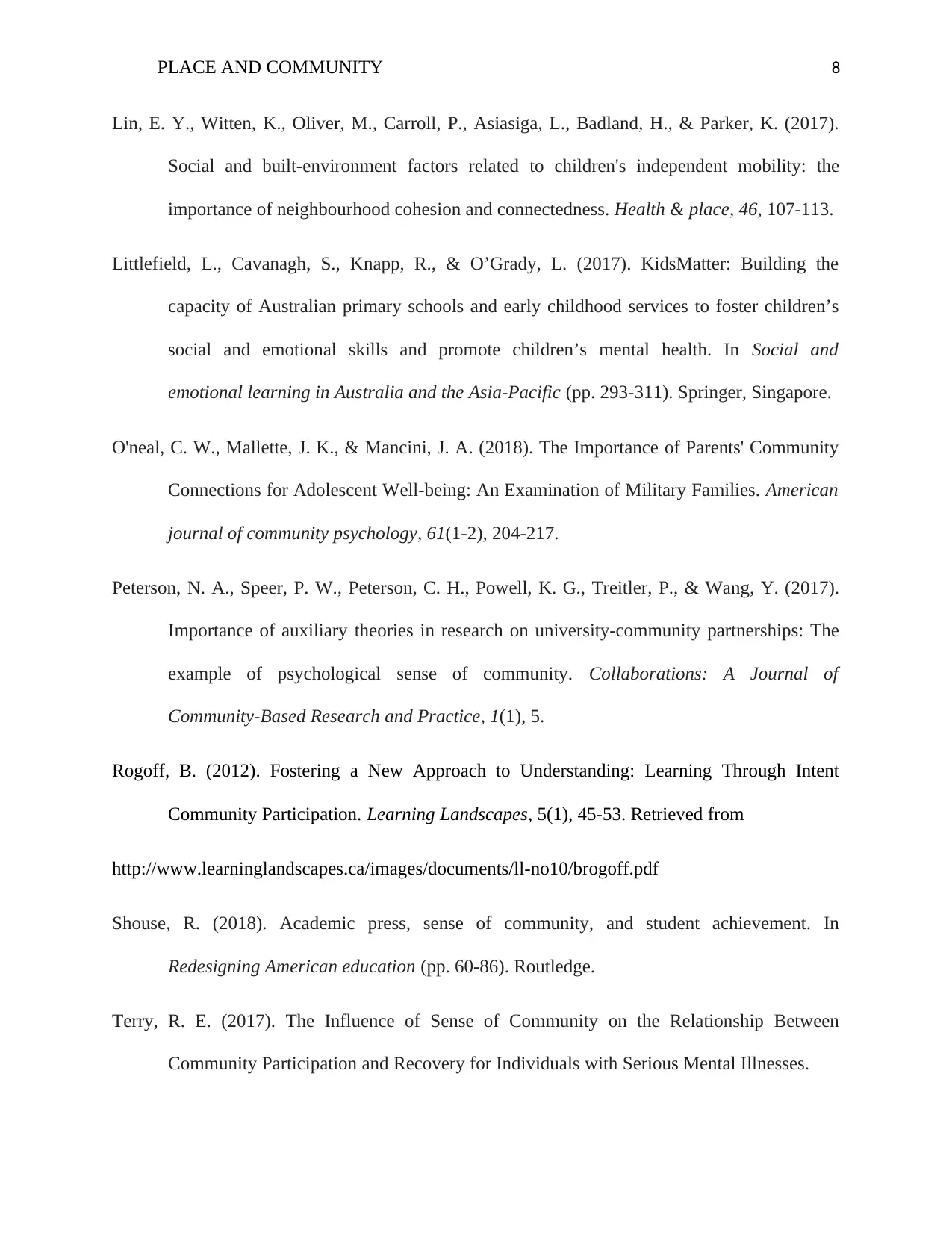
PLACE AND COMMUNITY 8
Lin, E. Y., Witten, K., Oliver, M., Carroll, P., Asiasiga, L., Badland, H., & Parker, K. (2017).
Social and built-environment factors related to children's independent mobility: the
importance of neighbourhood cohesion and connectedness. Health & place, 46, 107-113.
Littlefield, L., Cavanagh, S., Knapp, R., & O’Grady, L. (2017). KidsMatter: Building the
capacity of Australian primary schools and early childhood services to foster children’s
social and emotional skills and promote children’s mental health. In Social and
emotional learning in Australia and the Asia-Pacific (pp. 293-311). Springer, Singapore.
O'neal, C. W., Mallette, J. K., & Mancini, J. A. (2018). The Importance of Parents' Community
Connections for Adolescent Well‐being: An Examination of Military Families. American
journal of community psychology, 61(1-2), 204-217.
Peterson, N. A., Speer, P. W., Peterson, C. H., Powell, K. G., Treitler, P., & Wang, Y. (2017).
Importance of auxiliary theories in research on university-community partnerships: The
example of psychological sense of community. Collaborations: A Journal of
Community-Based Research and Practice, 1(1), 5.
Rogoff, B. (2012). Fostering a New Approach to Understanding: Learning Through Intent
Community Participation. Learning Landscapes, 5(1), 45-53. Retrieved from
http://www.learninglandscapes.ca/images/documents/ll-no10/brogoff.pdf
Shouse, R. (2018). Academic press, sense of community, and student achievement. In
Redesigning American education (pp. 60-86). Routledge.
Terry, R. E. (2017). The Influence of Sense of Community on the Relationship Between
Community Participation and Recovery for Individuals with Serious Mental Illnesses.
Lin, E. Y., Witten, K., Oliver, M., Carroll, P., Asiasiga, L., Badland, H., & Parker, K. (2017).
Social and built-environment factors related to children's independent mobility: the
importance of neighbourhood cohesion and connectedness. Health & place, 46, 107-113.
Littlefield, L., Cavanagh, S., Knapp, R., & O’Grady, L. (2017). KidsMatter: Building the
capacity of Australian primary schools and early childhood services to foster children’s
social and emotional skills and promote children’s mental health. In Social and
emotional learning in Australia and the Asia-Pacific (pp. 293-311). Springer, Singapore.
O'neal, C. W., Mallette, J. K., & Mancini, J. A. (2018). The Importance of Parents' Community
Connections for Adolescent Well‐being: An Examination of Military Families. American
journal of community psychology, 61(1-2), 204-217.
Peterson, N. A., Speer, P. W., Peterson, C. H., Powell, K. G., Treitler, P., & Wang, Y. (2017).
Importance of auxiliary theories in research on university-community partnerships: The
example of psychological sense of community. Collaborations: A Journal of
Community-Based Research and Practice, 1(1), 5.
Rogoff, B. (2012). Fostering a New Approach to Understanding: Learning Through Intent
Community Participation. Learning Landscapes, 5(1), 45-53. Retrieved from
http://www.learninglandscapes.ca/images/documents/ll-no10/brogoff.pdf
Shouse, R. (2018). Academic press, sense of community, and student achievement. In
Redesigning American education (pp. 60-86). Routledge.
Terry, R. E. (2017). The Influence of Sense of Community on the Relationship Between
Community Participation and Recovery for Individuals with Serious Mental Illnesses.
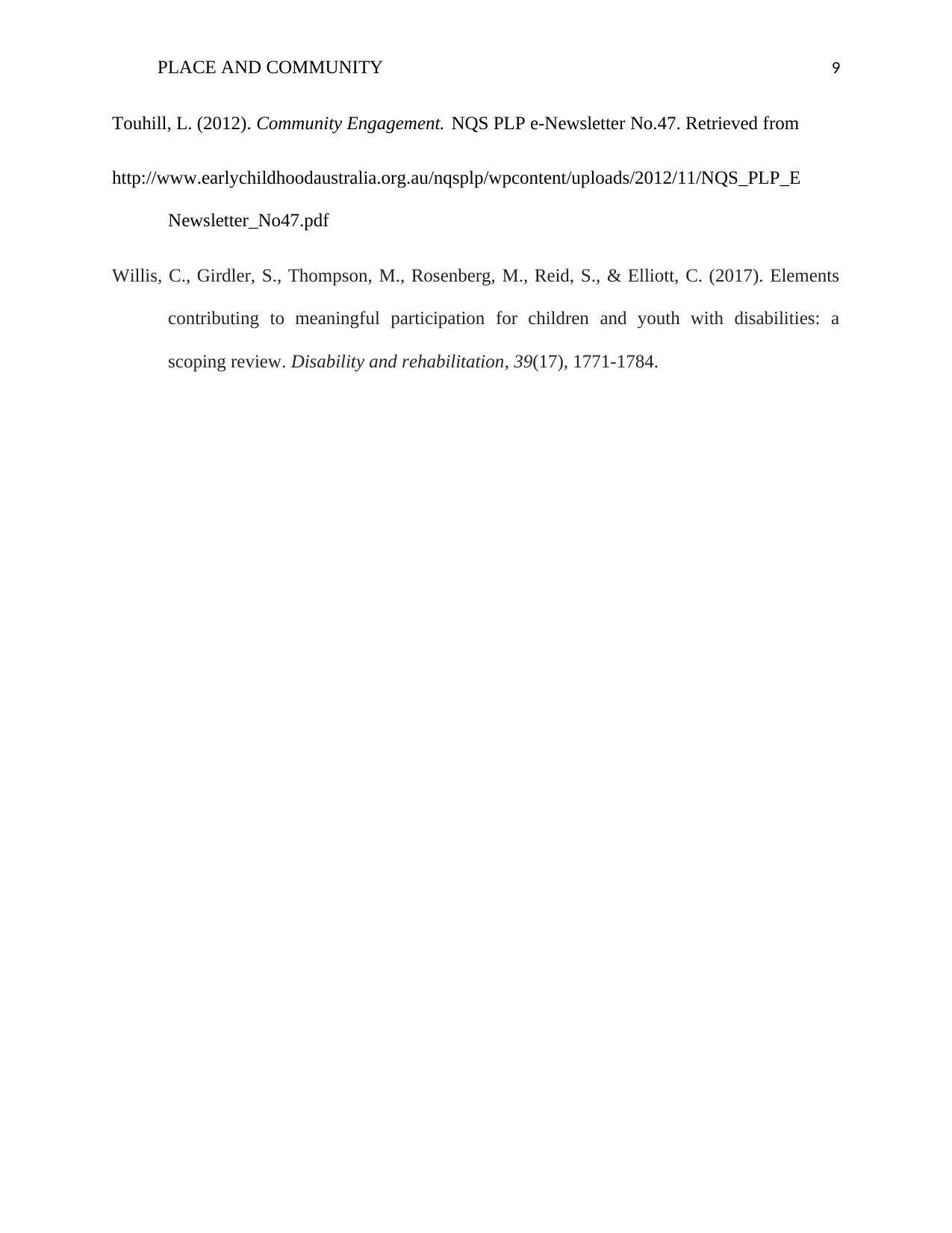
PLACE AND COMMUNITY 9
Touhill, L. (2012). Community Engagement. NQS PLP e-Newsletter No.47. Retrieved from
http://www.earlychildhoodaustralia.org.au/nqsplp/wpcontent/uploads/2012/11/NQS_PLP_E
Newsletter_No47.pdf
Willis, C., Girdler, S., Thompson, M., Rosenberg, M., Reid, S., & Elliott, C. (2017). Elements
contributing to meaningful participation for children and youth with disabilities: a
scoping review. Disability and rehabilitation, 39(17), 1771-1784.
Touhill, L. (2012). Community Engagement. NQS PLP e-Newsletter No.47. Retrieved from
http://www.earlychildhoodaustralia.org.au/nqsplp/wpcontent/uploads/2012/11/NQS_PLP_E
Newsletter_No47.pdf
Willis, C., Girdler, S., Thompson, M., Rosenberg, M., Reid, S., & Elliott, C. (2017). Elements
contributing to meaningful participation for children and youth with disabilities: a
scoping review. Disability and rehabilitation, 39(17), 1771-1784.
1 out of 9
Related Documents
Your All-in-One AI-Powered Toolkit for Academic Success.
+13062052269
info@desklib.com
Available 24*7 on WhatsApp / Email
![[object Object]](/_next/static/media/star-bottom.7253800d.svg)
Unlock your academic potential
© 2024 | Zucol Services PVT LTD | All rights reserved.





